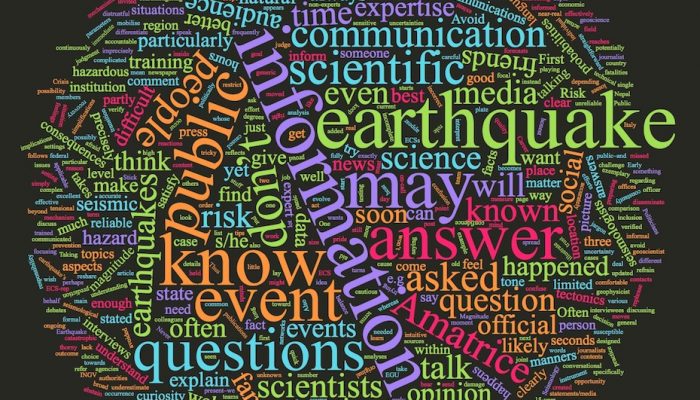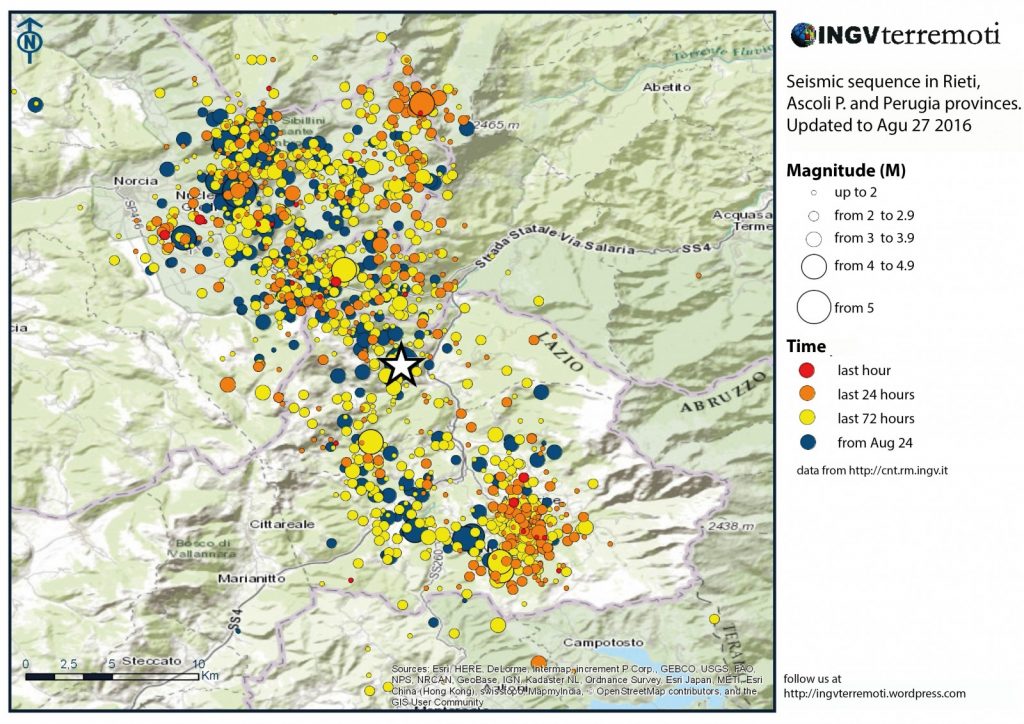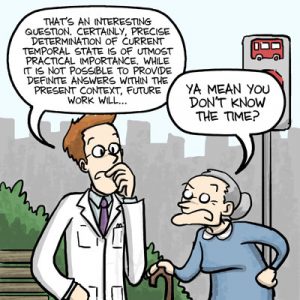
When events such as the Aug 28 2016 Amatrice earthquake occur, we seismologists are asked to answer scientific questions and to give an immediate judgment of the situation. Such questions may be asked by media officers during formal interviews or by friends and family members in person or even on the social networks in informal settings (sometimes only a few seconds after the earthquake’s occurrence). The choice of words and tone is not straightforward because in these catastrophic situations the public is very susceptible to misunderstandings. The public may even feel distrustful towards scientists that convey complex contents in a too technical language. While some experienced scientists may be used to answering such questions, Early Career Scientists often lack training to give answers to satisfy the righteous curiosity of the public and to avoid disengaging people with science.
Therefore, we invited three seismologists and three communication officers to discuss this topic with the SM ECS-rep team. First, we requested to talk about the scope and the manners of the scientific communication after an event like the Amatrice Earthquake in an official setting (e.g. press conference, official website or social media page of an institution).
Dr. Francesca Serra, communication officer at King Abdullah University of Science and Technology (KAUST), explained us some basics of communication in such case:
communication […] to be effective, should not be scientific, but designed to deal with both the actual risk (science) and the perception of the risk (social). For this reason the most appropriate communication should always be a “Risk Communication”, a communication that takes into consideration both aspects of risk perception. […] Risk Communication is […] an instrument for social inclusion, individual empowerment and joint control and management of hazardous situations.
In her discussion, Dr. Bárbara Ferreira, EGU Media and Communications Manager, highlighted the main role of the communication after such events: For authorities, decision makers and journalists, it is better to have good estimates in real or near-real time than perfect estimates a few hours after an earthquake because they need to act quickly to mobilise rescue teams, aid in recovery efforts, and to inform the public.
Dr. Anne Obermann, Senior Scientist at Swiss Seismological Service described how this rapid information dissemination is achieved in Switzerland after a major seismic event: We have an on-call service that is informed 24/7 about magnitude and location of earthquakes. Reports [..] are created automatically and accessible on the webpage within seconds, where it is well stated that this information has not been verified yet. We then verify the accuracy […] and send out alerts to various federal offices, news agencies and other media. For earthquakes of public interest […] we post more extensive information on the website once we have more accurate information [..] that is updated constantly. Also, on the manners of the communication, she stated: In my opinion, in official statements/media interviews only scientific information should be communicated. I think there is no place for personal opinions or political topics in such a context, partly, because our expertise is limited and partly because we are representing our institute.
Prof. Andrea Morelli, Chief Scientist at Istituto Nazionale di Geofisica e Vulcanologia (INGV), agreed with her on the style of the communication: First of all, when you are seen as talking on behalf of some laboratory or institution, you must always refrain from giving your personal feelings, and stick to a single, ‘official’, picture […] You should show that you are in control, and the news is clear. […] You may be asked a thorny question, that may be too difficult to answer in a sentence or two. Do not trust the possibility to have time enough to explain! The first sentence should do, in case rephrase the issue and precisely ask yourself the quick question you wish to answer.
Martin Mai, Professor of Earth Science and Engineering at KAUST, pointed out an important aspect of the communication: The scientific community continuously debates how to best communicate science and its implications, specifically if hazard and risk are the topics. Addressing the public after such devastating events is particularly difficult, and does not come natural to most of us, but requires practice and training.[…] I think that as scientists we have the responsibility to inform precisely about what is known and not known, and to abstain from speculations.

Map of the seismic sequence from Aug 24 2016 updated to Aug 27 at 18h00. The star represents the event of magnitude 6.0 occurred on 24 Aug at 3h32. Modified from https://ingvterremoti.wordpress.com/2016/08/27/sequenza-sismica-tra-le-province-di-rieti-perugia-ascoli-piceno-laquila-e-teramo-aggiornamento-delle-ore-18-00-27-agosto/
Our communication officers also advised on when communication should take place. They underlined again the need for rapid information after an event, but it was also mentioned that ideally, communication should take place all the time, not only in case of a crisis:
SERRA: Only before the hazard takes place it is possible discussing openly and with clear minds about the outcome and management of a possible hazardous event. After the event, as a matter of fact, the communication–technically speaking–does not refer any more to the risk but to the mitigation of the ongoing crisis, and for that we have the term Crisis Communication that follows different mechanisms and dynamics.
FERREIRA: If a potentially destructive earthquake happened in your country and you are the press or communications officer for the national geoscience institute (e.g. the INGV in the case of the Amatrice earthquake) you have to put out information about the event as soon as possible. By this I mean, as early as you have estimates for the main parameters of the earthquake, such as magnitude, depth and location, even if these estimates are not 100% reliable very soon after the event. […] when a destructive earthquake happens, the news moves very quickly from focusing on the seismic properties of the earthquake (an area where you as a seismologist can comment on) to the fatalities and economic losses (which is likely not your expertise). If you don’t answer within a few hours of the event, you’ll likely have missed your opportunity to provide information the public is interested in.
.
A very interesting facet of today’s topic is who should communicate. Here, two of our respondents agree with the fact that scientists, and in particular seismologists, should be the only ones answering to scientific questions.
MAI: Communicating with the public, with the media, requires training. […] Public scientific communications regarding natural (or any) disaster should be in the hands of people (scientists/experts) who are trained to effectively disseminate information to a broad audience. […] As scientists, we should try to stick to our domains of expertise when communicating with the general public. Personally, I try not to answer questions that are far from my domain of expertise (like on political implications or decision making) since I think this may easily lead to confusion and misunderstandings, but of course other people will handle this aspect differently.
FERREIRA: Even if you are not an expert in the region where the earthquake happened, as a seismologist, you are qualified to answer questions about earthquakes. If a journalist reaches out to you for information and you say that you don’t want to answer any questions about an event in Italy because your expertise is in earthquakes in Nepal, it is likely they will simply move on to the next geoscientist on their contacts list, who may not even be a seismologist! Do your best to answer questions accurately and clearly, and if you don’t know something or don’t have enough information to answer a specific question, don’t be afraid to say “I don’t know”.
.
A more specific side we asked to comment is the communication of the uncertainty.
MORELLI: Magnitude turns out to be a number to which people are particularly sensitive. How to balance confidence with uncertainty? […] It is then tricky to convey the idea of uncertainty if you want to appear dependable –sometimes your audience may think that you are unreliable if you are too cautious. One thing that you should point out, however, is that the picture you are giving reflects well the current state of knowledge, that will evolve with time as more data are added and better analyses come out. In this way, you are not saying that someone might do a better job, but just that more work is needed.
MAI:
Scientists should state that it may take time, more data, and further analysis to fully understand the size of the event and its consequences, and that after an hour or a day, we may still have only incomplete information. […] It is particularly difficult to communicate uncertainties, or even probabilities, as most of us don’t have an intuitive understanding how to interpret probabilities. Therefore, we should make an effort to clearly explain the facts, the data, the known details, to then make the transition to why other aspects of the event, its cause and consequences, are not yet, or only imprecisely, known.
FERREIRA: A way to deal with communicating uncertainty, is simply by stating that the values you are giving represent the best estimates for the data available at that moment and that they might change as more data becomes available. This is what the INGV does, for example.
.
Then, we moved toward questions more specific for ECSs. In fact, soon after the Amatrice seismic event, we ECS in Seismology have been frequently asked by family, friends and non-seismology colleagues a very generic question about what happened in Amatrice. Our common reactions are, in this order: panic (is s/he testing my knowledge?), pride (s/he wants to know my opinion because of my degrees and scientific publications), confusion (from where should I start? what does exactly s/he want to hear from me?). Thus, we asked to our interviewees what kind of answer we should give to satisfy curiosity and keep the interest to science high. Here their answers:
MORELLI:
You are a geophysicist, you know the matter from inside: be relaxed. […] Often, questions quickly get to earthquake prediction: for many people this appears to be the only goal of the seismological community. Avoid the comparison with meteorologists (who of course make excellent forecasts) and talk instead about what we do know about earthquakes–it’s a lot! Never underestimate seismic hazard in any region, and always get into talking about prevention as the most important measure for mitigation.
FERREIRA: A thing to bear in mind when addressing someone who is not an expert is to be conversational and speak at a level a 15-year old would understand. Avoid jargon: don’t talk about “focal mechanism” or “tensional tectonics” because your audience won’t know what those things are. Stick to terms you would find on a newspaper article. You can find other tips on communicating with the media, which, to a certain extent, are also applicable when speaking to family and friends, on the EGU website.

From “Communication as a Scientist” http://www.nature.com/scitable/ebooks/english-communication-for-scientists-14053993/communicating-as-a-scientist-14238273
MAI: Again, we need to be honest about what we know, what we don’t know just yet, and what perhaps will not be known at all for a long time. Taking an earthquake as an example, I explain where it happened, and why (natural events → plate tectonics; for possibly induced earthquakes, this becomes more complicated), and why this particular one may have caused so much (or little) damage. Often the challenge then is, depending on your audience at that moment, to find the right tone and language, and the appropriate level of simplifications. As scientists, we are often “proud to show off with all the stuff we think we know”, but that may confuse the people whose questions we are trying to answer.
OBERMANN: When I talk with my family or friends, it happens that I am politically incorrect and do state my personal opinion, however, I try my best to communicate it as such. This is very important, as non-experts cannot differentiate between my opinion and facts. When I talk to the public–and the public starts for me as soon as unknown people are present–we should be much more careful and restrict ourselves to the science. An exemplary question to illustrate this: “Who is to be held accountable for the tragedy in Amatrice? Could this have been avoided?”. This is not on us to judge!
.
Our doubts about communication after a disaster as the Amatrice earthquake were stronger when thinking about how to speak on social media. We then asked to Laura Roberts-Artal, Communications Officer at EGU with expertises in social media, gave us very useful advices: if you don’t feel comfortable preparing original content about the earthquake, that’s ok. What you can do is reshare information from reliable sources about the earthquake. The lay person won’t know where to look for good quality information, whereas you will. Not only will you be helping others to learn more, you’ll be playing an important role in stopping the spread of misinformation and scaremongering.
.
We thank Andrea, Anne, Barbara, Francesca, Laura and Martin for their time, useful information and advices. Here there are their full answers.
.
This post was planned and edited by the SM ECS-reps Laura Parisi, Lucia Gualtieri and Laura Ermert, in collaboration with all the ECS-rep team [sm-ecs @ egu.eu].
BIOGRAPHIES
Andrea Morelli is a seismologist, Chief Scientist at Istituto Nazionale di Geofisica e Vulcanologia (INGV), he also teaches courses as Adjunct Professor at Università di Bologna. He studied in Bologna and Harvard University, and has previously worked in Rome at ING, and at Università di Urbino. His main interest is seismic tomography, and the study of earth structure at different scales. He has been involved in seismic instrumentation projects, in the Mediterranean region and in Antarctica.
Bárbara Ferreira is the Media and Communications Manager of the European Geosciences Union. She is responsible for the Union’s communication activities, from coordinating the EGU newsletter to members and overseeing the blogging and social media activities of the organisation, to publishing press releases for journalists and organising press conferences. She has a PhD in astrophysics from the University of Cambridge.
Anne Obermann is a seismologist at Swiss Seismological Service. She obtained her PhD degree in 2013 in Grenoble under the supervision of Michel Campillo and Eric Larose. Her research focused on monitoring and locating tiny perturbations in the subsurface using multiply scattered coda waves from ambient noise correlations. Since 2014 she is working for the Swiss Seismological Service at ETH Zurich, first as a postdoc and now as a senior researcher with focus on different aspects of imaging with ambient noise data and induced seismicity.
Francesca Serra coordinates the communications of the CEMSE Division, KAUST, since 2015. Prior to her affiliation with KAUST, Francesca worked for the SISSA of Trieste as manager of a science communication EU project funded by the 7th Framework Programme in collaboration with 8 European Institutes of Research. Before SISSA, Francesca worked for 9 years as senior officer at the Joint Research Centre of the European Commission both in Italy and in Belgium. Francesca is also an official organiser of TEDx, touring exhibitions and scientific events.
Laura Roberts-Artal is the Communications Officer at the European Geosciences Union. She is responsible for the management of the Union’s social media presence and the EGU blogs, where she writes regularly for the EGU’s official blog, GeoLog. She is also the point of contact for early career scientists (ECS) at the EGU Office. Laura has a PhD in palaeomagnetism from the University of Liverpool.
P. Martin Mai is professor in the Physical Sciences and Engineering Division at KAUST. He joined KAUST in June 2009 as founding faculty member. Prior to his affiliation with KAUST, Prof. Mai worked as senior research scientist at ETH Zurich, Switzerland. In 2015, he was elected Division President of the Seismology Division of the European Geosciences Union (EGU). His research interests include the physics of earthquakes and the complexity of earthquake phenomena, focusing on earthquake-source imaging, dynamic rupture modeling, and earthquake mechanics.

What Is Effective Communication
I have been reading out a few of your posts and i must say clever stuff. I will make sure to bookmark your blog.